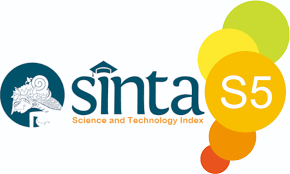Prediksi Harapan Hidup Pasien Kanker Paru Pasca Operasi Bedah Toraks Menggunakan Boosted k-Nearest Neighbor
DOI:
https://doi.org/10.51977/jti.v1i1.66Keywords:
thoracic surgery, life expectancy, k-nearest neighbor.Abstract
Kanker paru-paru menempati peringkat enam dari sepuluh penyakit penyebab kematian terbanyak di Indonesia. Faktor penyebab kanker paru-paru didominasi oleh asap rokok. Operasi bedah toraks menjadi salah satu solusi utama untuk kanker paru-paru. Akan tetapi, terdapat banyak resiko dan komplikasi pasca operasi bedah toraks hingga berujung pada kematian. Pada penelitian ini, akan di prediksi harapan hidup pasien kanker paru-paru setelah menjalani kehidupan satu tahun pasca operasi bedah toraks menggunakan computer aided diagnosis (CAD). Prediksi ini dilakukan dengan menganalisa kondisi pasien sebelum dan sesudah operasi. Data yang digunakan pada penelitian ini merupakan data sekunder yang berisi 470 data dengan sebaran 400 data pasien yang hidup (survival) dan 70 data pasien yang meninggal (die). Adaptive Boost digunakan sebagai optimasi level algoritma pada algoritma k-nearest neighbor. Hasil penelitian menunjukan bahwa metode yang diusulkan menghasilkan akurasi prediksi harapan hidup sebesar 85.11% menggunakan validasi 10 fold cross validation dengan parameter k pada algoritma k-nearest neighbor bernilai 5.
References
Berndtsson, M., Hansson, J., Olsson, B., & Lundell, B. (2008). Thesis Projects : A Guide for Students in Computer Science and Information Systems 2nd Edition. London: Springer.
Bourquin, J., Schmidli, H., Hoogevest, P. v., & Leuenberger, H. (2018). Advantages of Artificial Neural Networks (ANNs) as alternative modelling technique for data sets showing non-linear relationships using data from a galenical study on a solid dosage form. European Journal of Pharmaceutical Sciences, 5-16.
Dawson, C. W. (2009). Projects in Computing and Information Systems : A Student's Guide 2nd Edition. London: Pearson Education Limited.
Desuky, A. S., & El Bakrawy , L. M. (2016). Improved prediction of post-operative life expectancy after Thoracic Surgery. Advance in System Science Application, 70-80.
Ferguson, M. K. (2007). Thoracic Surgery Atlas. Elsevier.
Global Health Data Exchange. (2014). Indonesia Sample Registration System - Deaths. Washington: GHDx.
Hachesu, P. R., Moftian, N., Dehghani, M., & Soltani, T. S. (2017). Analyzing a Lung Cancer Patient Dataset with the Focus on Predicting Survival Rate One Year after Thoracic Surgery. Asian Pacific Journal of Cancer Prevention, 1531-1536.
Huang, Q., Chen, Y., Liu, L., Tao, D., & Li, X. (2019). On Combining Biclustering Mining and AdaBoost for Breast Tumor Classification. IEEE Transactions on Knowledge and Data Engineering, 1.
Hui, B., Zhou, H., Jiang, Y., Ji, L., & Chen, J. (2017). The Research of Postoperative Life Expectancy of Lung Cancer Based on Semi Naive Bayesian. Computer Science and Artificial Intelligence(CSAI), 17-19.
Kementerian Kesehatan Republik Indonesia. (2014). InfoDATIN Kanker. Jakarta: Pusat Data dan Informasi Kementerian Kesehatan Republik Indonesia.
Koklu, M., Kahramanli, H., & Allahverdi, N. (2015). APPLICATIONS OF RULE BASED CLASSIFICATION TECHNIQUES FOR THORACIC SURGERY. Managing Intellectual Capital and Innovation for Sustainable and Inclusive Society Management, Knowledge and Learning Joint International Conference (pp. 1991-1998). Bari: Technology, Innovation and Industrial Management.
Prasetio, R. T., & Pratiwi, P. (2015). PENERAPAN TEKNIK BAGGING PADA ALGORITMA KLASIFIKASI UNTUK MENGATASI KETIDAKSEIMBANGAN KELAS DATASET MEDIS. Jurnal Informatika, 2(2).
Prasetio, R. T., & Riana, D. (2015, November). A comparison of classification methods in vertebral column disorder with the application of genetic algorithm and bagging. In 2015 4th international conference on instrumentation, communications, information technology, and biomedical engineering (ICICI-BME) (pp. 163-168). IEEE.
Prasetio, R. T., & Ripandi, E. (2019). Optimasi Klasifikasi Jenis Hutan Menggunakan Deep Learning Berbasis Optimize Selection. Jurnal Informatika, 6(1), 100-106.
Prasetio, R. T., Rismayadi, A. A., & Anshori, I. F. (2018). Implementasi Algoritma Genetika pada k-nearest neighbours untuk Klasifikasi Kerusakan Tulang Belakang. Jurnal Informatika, 5(2), 186-194.
Riana, D., Ramdhani, Y., Rizki, T. P., & Hidayanto, A. N. (2018). Improving Hierarchical Decision Approach for Single Image Classification of Pap Smear. International Journal of Electrical and Computer Engineering, 8(6), 5415.
Sharma, A., & Chopra, A. (2013). Artificial Neural Networks: Applications In Management. IOSR Journal of Business and Management (IOSR-JBM), 32-40.
Sharma, A., & Dey, S. (2013). A boosted SVM based sentiment analysis approach for online opinionated text. Proceedings of the 2013 Research in Adaptive and Convergent Systems (pp. 28-34). Montreal: ACM.
Shields, T. W., Reed, C. E., LoCicero, J., & Feins, R. H. (2009). General Thoracic Surgery. Philadelphia: Wolters Kluwer Business.
Zieba, M., Tomczak, J. M., Lubicz, M., & Swiatek, J. (2013). Boosted SVM for extracting rules from imbalanced data in application to prediction of the post-operative life expectancy in the lung cancer patients. Applied Soft Computing, 99-108.
Zieba, M., Tomczak, J. M., Lubicz, M., & Swiatek, J. (2014). Boosted SVM for extracting rules from imbalanced data in application to prediction of the post-operative life expectancy in the lung cancer patients. Applied Soft Computing, 99-108.
Downloads
Published
Issue
Section
License
Pemberitahuan Hak Cipta
Usulan kebijakan untuk jurnal yang menawarkan akses terbuka Syarat yang dibutuhkan penulis adalah sebagai berikut:
1. Penulis memegang hak cipta dan memberikan jurnal hak penerbitan pertama secara bersamaan di bawah lisensi di bawah Creative Commons Attribution-ShareAlike 4.0 International (CC BY-SA 4.0), yang mengizinkan orang lain untuk menyalin dan mendistribusikan ulang materi ini dalam bentuk atau format apa pun termasuk menyusun, memodifikasi, dan membuat turunan materi ini untuk tujuan apa pun, termasuk tujuan komersial.
2. Penulis dapat membuat pengaturan kontrak terpisah untuk distribusi non-eksklusif dari versi dekaden publikasi jurnal (misalnya mempostingnya ke repositori institusional atau menerbitkannya dalam sebuah buku), dengan mengakui publikasi aslinya di jurnal ini.
3. Penulis diizinkan dan didorong untuk memposting artikel secara online (misalnya di repositori institusional atau di situs web mereka) seperti pada Garuda, Academia, researchgate atau repository lainnya sebelum dan selama proses pengiriman, karena dapat menghasilkan pertukaran yang produktif dan kutipan artikel yang diterbitkan lebih awal dan lebih maju (periksa: Efek Akses Terbuka)

This work is licensed under a Creative Commons Attribution-ShareAlike 4.0 International License.











